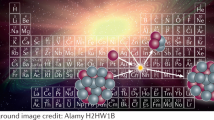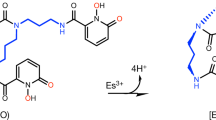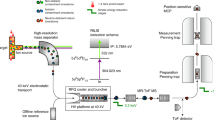Abstract
The synthesis, via nuclear fusion reactions, of elements heavier than the actinides, allows one to probe the limits of the periodic table as a means of classifying the elements. In particular, deviations in the periodicity of chemical properties for the heaviest elements are predicted as a consequence of increasingly strong relativistic effects on the electronic shell structure1,2,3,4,5,6,7. The transactinide elements have now been extended up to element 112 (ref. 8), but the chemical properties have been investigated only for the first two of the transactinide elements, 104 and 105 (refs 9,10,11,12,13,14,15,16,17,18,19). Those studies showed that relativistic effect render these two elements chemically different from their lighter homologues in the same columns of the periodic table (Fig. 1). Here we report the chemical separation of element 106 (seaborgium, Sg) and investigations of its chemical behaviour in the gas phase and in aqueous solution. The methods that we use are able to probe the reactivity of individual atoms, and based on the detection of just seven atoms of seaborgium we find that it exhibits properties characteristic of the group 6 homologues molybdenum and tungsten. Thus seaborgium appears to restore the trends of the periodic table disrupted by relativistic effects in elements 104 and 105.

The arrangement of the actinides reflects the fact that the first actinide elements still resemble, to a decreasing extent, the chemistry of the other groups: Th the fourth group below Hf, Pa the fifth group below Ta, and U the sixth group below W. The known transactinide elements 104 to 112 take the positions from below Hf in group 4 to below Hg in group 12. Element 106, seaborgium (Sg), the heaviest element chemically investigated, is placed in group 6.
This is a preview of subscription content, access via your institution
Access options
Subscribe to this journal
Receive 51 print issues and online access
$199.00 per year
only $3.90 per issue
Buy this article
- Purchase on Springer Link
- Instant access to full article PDF
Prices may be subject to local taxes which are calculated during checkout


Similar content being viewed by others
References
Fricke, B. & Greiner, W. On the chemistry of superheavy elements around Z = 164. Phys. Lett. B 30, 317–319 (1969).
Desclaux, J.-P. & Fricke, B. Relativistic prediction of the ground state of atomic lawrencium. J. Phys. 41, 943–946 (1980).
Glebov, V. A., Kasztura, L., Nefedov, V. S. & Zhuikov, B. L. Is element 104 (kurchatovium) a p-element? II. Relativistic calculations of the electronic atomic structure. Radiochim. Acta 46, 117–121 (1989).
Johnson, E., Fricke, B., Keller, O. L., Nestor, C. W. & Tucker, T. C. Ionization potentials and radii of atoms and ions of element 104 (unnilquadium) and of hafnium (2+) derived from multiconfiguration Dirac-Fock calculations. J. Chem. Phys. 93, 8041–8050 (1990).
Eliav, E., Kaldor, U. & Ishikawa, Y. Ground state electron configuration of rutherfordium: role of dynamic correlation. Phys. Rev. Lett. 74, 1079–1082 (1995).
Pyykkö, P. Relativistic effects in structural chemistry. Chem. Rev. 88, 563–594 (1988).
Pershina, V. G. Electronic structure and properties of the transactinides and their compounds. Chem. Rev. 96, 1977–2101 (1996).
Hofmann, S. et al. The new element 112. Z. Phys. A 354, 229–230 (1996).
Zvara, I., Belov, V. Z., Domanov, V. P. & Shalaevskii, M. R. Chemical isolation of nilsbohrium as ekatantalum in the form of the anhydrous bromide. II. Experiments with a spontaneously fissioning isotope of nilsbohrium. Sov. Radiochem. 18, 328–334 (1976).
Gregorich, K. E. et al. Aqueous chemistry of element 105. Radiochim. Acta 43, 223–231 (1988).
Kratz, J. V. et al. Chemical properties of element 105 in aqueous solution: halide complex formation and anion exchange into triisooctyl amine. Radiochim. Acta 48, 121–133 (1989).
Gäggeler, H. W. et al. Gas phase chromatography experiments with bromides of tantalum and element 105. Radiochim. Acta 57, 93–100 (1992).
Gäggeler, H. W. On-line gas chemistry experiments with transactinide elements. J. Radioanal. Nucl. Chem. 183, 261–271 (1994).
Czerwinski, K. R. et al. Solution chemistry of element 104: Part I. Liquid–liquid extractions with triisoctylamine. Radiochim. Acta 64, 23–28 (1994); Solution chemistry of element 104: Part II. Liquid–liquid extractions with tributylphosphate. Radiochim. Acta 64, 29–35 (1994).
Türler, A. et al. On-line gas phase chromatography with chlorides of niobium and hahnium (element 105). Radiochim. Acta 73, 55–66 (1996).
Kadkhodayan, B. et al. On-line gas chromatographic studies of chlorides of rutherfordium and homologs Zr and Hf. Radiochim. Acta 72, 169–178 (1996).
Türler, A. Gas phase chemistry experiments with transactinide elements. Radiochim. Acta 72, 7–17 (1996).
Schädel, M. Chemistry of the transactinide elements. Radiochim. Acta 70/71, 207–223 (1996).
Hoffman, D. C. Chemistry of the heaviest elements. Radiochim. Acta 72, 1–6 (1996).
Zimmermann, H. P. et al. Chemical properties of element 105 in aqueous solution: back extraction from triisooctyl amide into 0.5 M HCl. Radiochim. Acta 60, 11–16 (1993).
Zvara, I. et al. Gas chromatography and thermochromatography in the study of transuranium elements. Sov. Radiochem. 16, 709–715 (1974).
Lougheed, R. W. et al. in Proc. Int. Conf. Actinides-93(eds Clark, D. L., Hobart, D. E. & Fuger, F.) 161 (Elsevier, Amsterdam, (1994)); J. Alloy Compounds 213/214, 61–66 (1994).
Lazarev, Yu. A. et al. Discovery of enhanced nuclear stability near the deformed shells N = 162 and Z = 108. Phys. Rev. Lett. 73, 624–627 (1994).
Schädel, M. et al. First aqueous chemistry with seaborgium (element 106). Radiochim. Acta(in the press).
Timokhin, S. N., Yakushev, A. B., Honggui Xu,, Perelygin, V. P. & Zvara, I. Chemical identification of element 106 by thermochromatography. J. Radioanal. Nucl. Chem. Lett. 212, 31–34 (1996).
Schädel, M. et al. ARCA II—a new apparatus for fast, repetitive HPLC separations. Radiochim. Acta 48, 171–176 (1989).
Tytko, K.-H. & Gras, D. in Gmelin, Handbook of Inorganic Chemistry, Molybdenum Suppl. Vol. B 3b(Springer, Heidelberg, (1989)).
Pershina, V. & Fricke, B. The electronic structure of the group 6 oxyanions [MO4]2−, where M = Cr, Mo, W, and element 106. Radiochim. Acta 65, 13–17 (1994).
Acknowledgements
We are indebted to the Division of Chemical Sciences, Office of Basic Energy Research, US Department of Energy, for making the 248Cm target material through the transplutonium element production program at the Oak Ridge National Laboratory. We also thank the staff and crew of the GSI UNILAC, the TRIGA Mainz reactor, the Philips-cyclotron at PSI, and the MPI Heidelberg tandem accelerator for their help. This work was supported in part by the Bundesministerium für Bildung, Wissenschaft, Forschung und Technologie (BMBF), the Swiss National Science Foundation, and the Chemical Sciences Division of the Office of Basic Energy Sciences, US Department of Energy.
Author information
Authors and Affiliations
Corresponding author
Rights and permissions
About this article
Cite this article
Schädel, M., Brüchle, W., Dressler, R. et al. Chemical properties of element 106 (seaborgium). Nature 388, 55–57 (1997). https://doi.org/10.1038/40375
Received:
Accepted:
Issue Date:
DOI: https://doi.org/10.1038/40375
This article is cited by
-
Extreme chemistry: experiments at the edge of the periodic table
Nature (2019)
-
Extraction behavior of Mo and W from H2SO4 and HF/HCl solutions into toluene with Aliquat336: sulfate and fluoride complex formation of Mo and W towards chemical studies of seaborgium (Sg)
Journal of Radioanalytical and Nuclear Chemistry (2018)
-
Measurement of the first ionization potential of lawrencium, element 103
Nature (2015)
-
Radiochemical studies of the heaviest elements at JAEA
Journal of Radioanalytical and Nuclear Chemistry (2014)
-
In situ synthesis of volatile carbonyl complexes with short-lived nuclides
Journal of Radioanalytical and Nuclear Chemistry (2014)
Comments
By submitting a comment you agree to abide by our Terms and Community Guidelines. If you find something abusive or that does not comply with our terms or guidelines please flag it as inappropriate.



